新模式英语 1-unit6 Health and Fitness
- 格式:ppt
- 大小:13.58 MB
- 文档页数:88
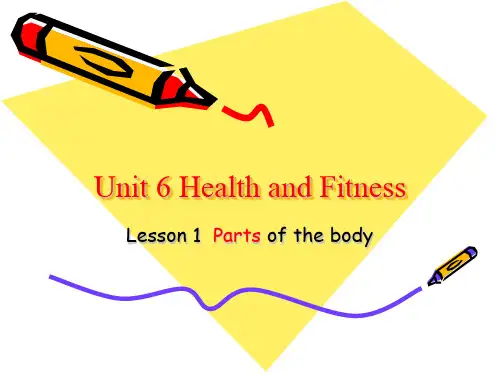
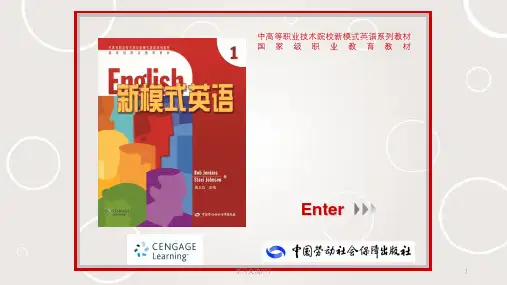
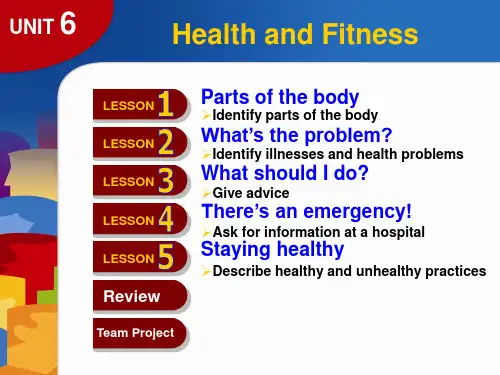
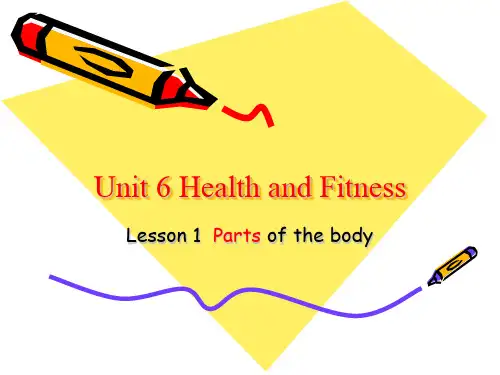
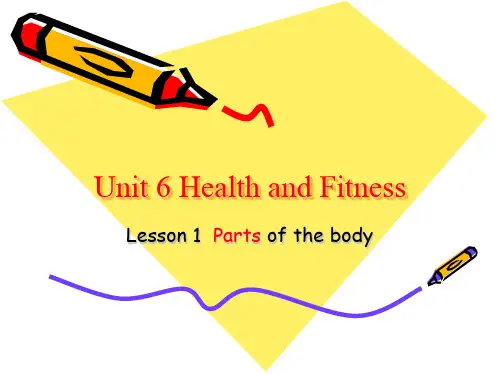
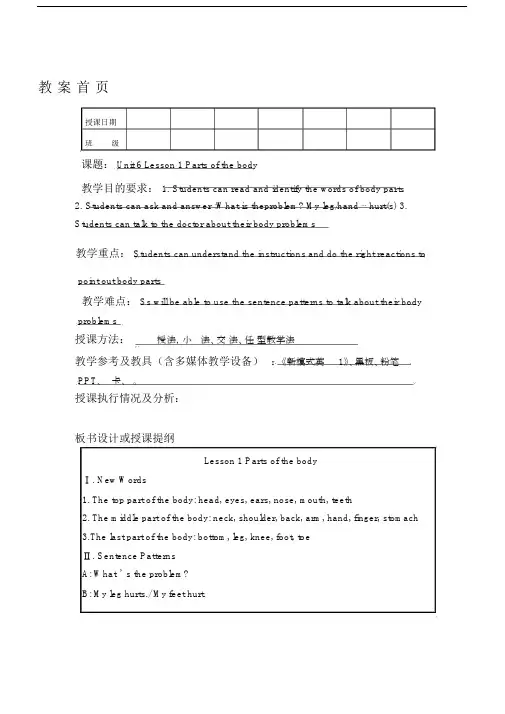
教案首页授课日期班级课题: Unit 6 Lesson 1 Parts of the body教学目的要求: 1. Students can read and identify the words of body parts2. Students can ask and answer :What is theproblem? My leg/hand ⋯ hurt(s)3.Students can talk to the doctor about their body problems教学重点: Students can understand the instructions and do the right reactions topoint out body parts教学难点: Ss will be able to use the sentence patterns to talk about their bodyproblems授课方法:授法,小法、交法、任型教学法教学参考及教具(含多媒体教学设备):《新模式英1》、黑板、粉笔PPT、卡、。
授课执行情况及分析:板书设计或授课提纲Lesson 1 Parts of the bodyⅠ. New Words1.The top part of the body: head, eyes, ears, nose, mouth, teeth2.The middle part of the body: neck, shoulder, back, arm, hand, finger, stomach3.The last part of the body: bottom, leg, knee, foot, toeⅡ. Sentence PatternsA:What ’ s the problem?B:My leg hurts./ My feet hurt.教学环节教学内容师生活动Ⅰ. Lead-in 1.Play a guessing gameAsk Ss to guess what the logo stand for 启(发学生回答这些知名的 logo 都是由肢体摆成的,让学生猜出本节课所讲内容)2.Write Parts“ of the body” on the board.3.State the objective: We’ ll say our body parts and talk to the doctor about body problems today. 通过让学生猜一些用身体摆成的 logo 导入课题,老师板书Ⅱ.PresentationA 1.Explain the teaching aims to students(向学生逐条解释学习目标)2.Group discussion(1)Divide the Ss into three groups, ask them towrite down the body parts which they have learnedbefore.(第一组写出与头部有关的单词,第二组写身体中间部分的单词,第三组写下半身的单词 )(2)Each group choose two students to report, oneread the word , the other student write the words onthe blackboard.(3)The teacher to supplement3. Teach the body words in different ways.(1)The top part of the body: head, eyes, ears,mouth and nose. a.出示一些卡通人物的图片让学生用 He/She/It has 这个句型来描述人物最有特点的身体部位。
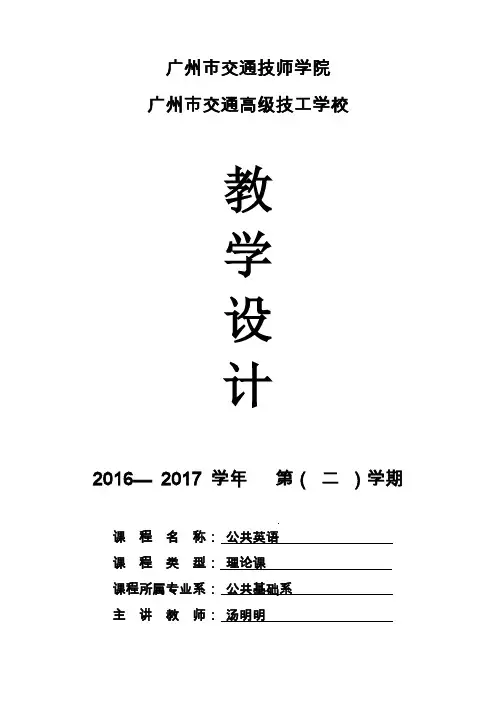
广州市交通技师学院
广州市交通高级技工学校
教
学
设
计
2016—2017 学年第(二)学期
课程名称:公共英语
课程类型:理论课
课程所属专业系:公共基础系
***师:***
广州市交通技师学院广州市交通高级技工学校教学设计(首页)(代号A-3)
教学实施过程(代号A-4)
广州市交通技师学院广州市交通高级技工学校教学设计(首页)(代号A-3)
教学实施过程(代号A-4)
广州市交通技师学院广州市交通高级技工学校教学设计(首页)(代号A-3)
教学实施过程(代号A-4)
广州市交通技师学院广州市交通高级技工学校教学设计(首页)(代号A-3)
教学实施过程(代号A-4)。
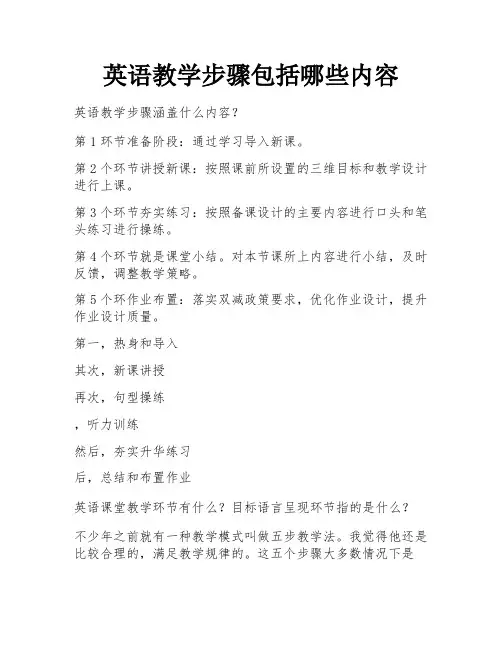
英语教学步骤包括哪些内容英语教学步骤涵盖什么内容?第1环节准备阶段:通过学习导入新课。
第2个环节讲授新课:按照课前所设置的三维目标和教学设计进行上课。
第3个环节夯实练习:按照备课设计的主要内容进行口头和笔头练习进行操练。
第4个环节就是课堂小结。
对本节课所上内容进行小结,及时反馈,调整教学策略。
第5个环作业布置:落实双减政策要求,优化作业设计,提升作业设计质量。
第一,热身和导入其次,新课讲授再次,句型操练,听力训练然后,夯实升华练习后,总结和布置作业英语课堂教学环节有什么?目标语言呈现环节指的是什么?不少年之前就有一种教学模式叫做五步教学法。
我觉得他还是比较合理的,满足教学规律的。
这五个步骤大多数情况下是revision,presentation,drill,practice,consolidation。
更多相关五步教学法的资料,请自行搜索。
答:从教学思想特别要注意关注的焦点来看,英语课堂的教学就是以教为中心和以学为中心的教学过程。
在中学英语低年级阶段,以"教"为中心的课程略多。
应该以教促进学,详细指导学的教。
英语课堂的教学基本环节有以下几点:一、热身,学习阶段。
方式:打招呼,问候,唱英歌,做游戏等。
形式:提问题,自由对话,复述上节课文,听写,造句,看英语小短片故事。
二、讲授新知识环节。
(presentation)方式:理解记忆,创设情景,图像记忆,思维导图等。
1、导入新课(lead in)通过设计好的活动,将学生引入新的课程内容中。
方式:话题导入;学习旧知识导入新课;听英文歌导入;角色扮演;多媒体导入。
2、呈现新知识(presentation)教师运用各自不同的教学方式向学生呈现新课内容,使学生感知,理解认识教师授课内容。
3、介绍新课(expⅰaining)教师在介绍新知识,要从已知引出未知,新知识的介绍要借助直观教具,情景教学,手势等演示,尽可能少说中文。
用简单易懂的英文介绍,可以提升学生的听力。
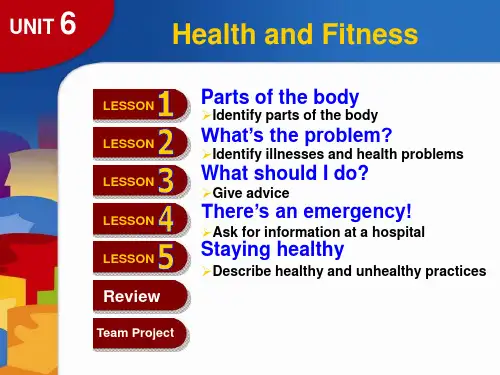

教案本教师姓名:授课班级:1722、1723、1712课程名称:新模式英语1教案编号:版本:流水号:授课教师:审阅签名:提交日期:2018.03.05 审阅日期:教学过程编号:版本:流水号:授课教师:审阅签名:提交日期:2018.03.05 审阅日期:教学过程教案编号:版本:流水号:授课教师:审阅签名:提交日期:2018.03.05 审阅日期:教学过程教案编号:版本:流水号:授课教师:审阅签名:提交日期:2018.03.05 审阅日期:教学过程教案编号:版本:流水号:授课教师:审阅签名:提交日期:2018.04.05 审阅日期:教学过程教案编号:版本:流水号:授课教师:审阅签名:提交日期:2018.04.05 审阅日期:教学过程教案编号:版本:流水号:授课教师:审阅签名:提交日期:2018.04.05 审阅日期:教学过程教案编号:版本:流水号:授课教师:金瑞亮审阅签名:提交日期:2018.04.05 审阅日期:教学过程编号:版本:流水号:授课教师:审阅签名:提交日期:2018.05.05 审阅日期:编号:版本:流水号:授课教师:审阅签名:提交日期:2018.05.05 审阅日期:编号:版本:流水号:授课教师:审阅签名:提交日期:2018.05.05 审阅日期:编号:版本:流水号:授课教师:审阅签名:提交日期:2018.05.05 审阅日期:编号:版本:流水号:授课教师:审阅签名:提交日期:2018.05.05 审阅日期:编号:版本:流水号:授课教师:金瑞亮审阅签名:提交日期:2018.06.05 审阅日期:编号:版本:流水号:授课教师:金瑞亮审阅签名:提交日期:2018.06.05 审阅日期:编号:版本:流水号:授课教师:金瑞亮审阅签名:提交日期:2018.06.05 审阅日期:编号:版本:流水号:授课教师:金瑞亮审阅签名:提交日期:2018.06.05 审阅日期:编号:版本:流水号:授课教师:金瑞亮审阅签名:提交日期:2018.06.05 审阅日期:教案编号:版本:流水号:授课教师:金瑞亮审阅签名:提交日期:2018.06.05 审阅日期:教学过程。
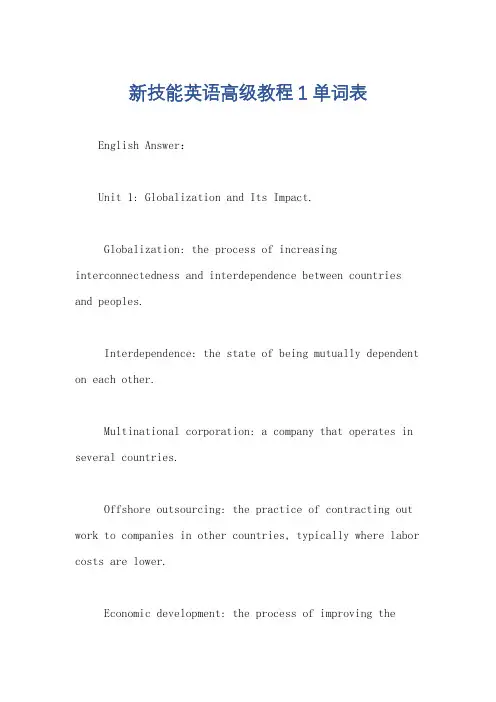
新技能英语高级教程1单词表English Answer:Unit 1: Globalization and Its Impact.Globalization: the process of increasing interconnectedness and interdependence between countries and peoples.Interdependence: the state of being mutually dependent on each other.Multinational corporation: a company that operates in several countries.Offshore outsourcing: the practice of contracting out work to companies in other countries, typically where labor costs are lower.Economic development: the process of improving theeconomic well-being of a country or region.Human development: the process of expanding human capabilities and choices.Sustainable development: development that meets the needs of the present without compromising the ability of future generations to meet their own needs.Unit 2: Technological Advancements.Artificial intelligence (AI): the ability of computers to perform tasks that normally require human intelligence.Blockchain: a distributed database that is used to maintain a continuously growing list of records, called blocks.Cloud computing: the delivery of computing services over the internet.E-commerce: the buying and selling of goods orservices over the internet.Internet of Things (IoT): the network of physical devices that are connected to the internet.Machine learning: the ability of computers to learn without being explicitly programmed.Virtual reality (VR): the use of computer technology to create a simulated environment that can be experienced by the user.Unit 3: Environmental Challenges.Climate change: the long-term alteration of temperature and typical weather patterns in a place.Deforestation: the clearing of forests.Desertification: the process by which land becomes desert.Environmental degradation: the damage or destruction of the natural environment.Extinction: the dying out of a species.Global warming: the gradual increase in the average temperature of the Earth's atmosphere.Pollution: the contamination of the natural environment with harmful substances.Unit 4: Social and Cultural Changes.Cultural diversity: the variety of cultural practices and beliefs that exist in a society.Cultural identity: the sense of belonging to a particular culture.Cultural relativism: the belief that all cultures are valid and should be respected.Globalization of culture: the spread of cultural practices and beliefs across national borders.Intercultural communication: communication between people from different cultural backgrounds.Social change: the transformation of socialinstitutions and practices over time.Social inequality: the unequal distribution of resources and opportunities in a society.Unit 5: Global Health and Well-being.Access to healthcare: the ability to obtain healthcare services when needed.Communicable diseases: diseases that can be transmitted from one person to another.Global health: the health of people around the world.Health disparities: the differences in health outcomes between different groups of people.Non-communicable diseases: diseases that are not transmitted from one person to another.Public health: the science and art of preventing disease, prolonging life, and promoting health through organized efforts.Universal health coverage: the provision of health services to all people, regardless of their ability to pay.Unit 6: International Relations.Diplomacy: the conduct of international relations through negotiation and dialogue.Foreign policy: the policy of a government towards other countries.Globalization of politics: the increasinginterconnectedness and interdependence of political systems around the world.International law: the body of law that governs relations between states.International organizations: organizations that are composed of member states and that work to promote cooperation among them.National security: the protection of a country from threats to its security.War: a state of armed conflict between two or more countries.中文回答:单元 1,全球化及其影响。
教案本教师姓名:授课班级:1722、1723、1712课程名称:新模式英语1教案编号:版本:流水号:授课教师:审阅签名:提交日期:2018.03.05 审阅日期:教学过程编号:版本:流水号:授课教师:审阅签名:提交日期:2018.03.05 审阅日期:教学过程教案编号:版本:流水号:授课教师:审阅签名:提交日期:2018.03.05 审阅日期:教学过程教案编号:版本:流水号:授课教师:审阅签名:提交日期:2018.03.05 审阅日期:教学过程教案编号:版本:流水号:授课教师:审阅签名:提交日期:2018.04.05 审阅日期:教学过程教案编号:版本:流水号:授课教师:审阅签名:提交日期:2018.04.05 审阅日期:教学过程教案编号:版本:流水号:授课教师:审阅签名:提交日期:2018.04.05 审阅日期:教学过程教案编号:版本:流水号:授课教师:金瑞亮审阅签名:提交日期:2018.04.05 审阅日期:教学过程编号:版本:流水号:授课教师:审阅签名:提交日期:2018.05.05 审阅日期:编号:版本:流水号:授课教师:审阅签名:提交日期:2018.05.05 审阅日期:编号:版本:流水号:授课教师:审阅签名:提交日期:2018.05.05 审阅日期:编号:版本:流水号:授课教师:审阅签名:提交日期:2018.05.05 审阅日期:编号:版本:流水号:授课教师:审阅签名:提交日期:2018.05.05 审阅日期:编号:版本:流水号:授课教师:金瑞亮审阅签名:提交日期:2018.06.05 审阅日期:编号:版本:流水号:授课教师:金瑞亮审阅签名:提交日期:2018.06.05 审阅日期:编号:版本:流水号:授课教师:金瑞亮审阅签名:提交日期:2018.06.05 审阅日期:编号:版本:流水号:授课教师:金瑞亮审阅签名:提交日期:2018.06.05 审阅日期:编号:版本:流水号:授课教师:金瑞亮审阅签名:提交日期:2018.06.05 审阅日期:教案编号:版本:流水号:授课教师:金瑞亮审阅签名:提交日期:2018.06.05 审阅日期:教学过程。
《新模式英语》课程授课教案第二步( 55分钟)学习新型冠状病毒肺炎知识以及课程设置播放相关图片及影响,再使用PPT进行讲解,并与学生进行问答互动。
听讲并回答问题学习新冠知识第三步( 10分钟)课程介绍介绍写作指导课程的学习目标,学习难易程度,学习内容。
跟着老师一起了解课程对课程有总体上对了解第四步( 5 分钟)总结及布置作业总结并布置作业做记录温故而知新内容讲解第一步( 10分钟)暖场及引入一、“同学们,这个假期大家已经感受到和往年不一样,爱动的我们被爸爸妈妈告知不能出门,到了开学的时间我们不能按时到校上课,新年没有了往年的热闹和喜庆,更甚的是,有很多无辜的生命因为一种可恶的病毒离开了亲人,同时我们也被无数无私奉献的可爱人儿感动着。
今年注定是非比寻常的一年。
接下来让我们来了解一下新型冠状病毒肺炎。
”二、视频及图片展示中国以及全球新型冠状病毒肺炎的感染人数,治愈人数,死亡人数的相关数据。
并展示其蔓延范围,并提出问题“什么是新型冠状肺炎?为什么它造成如此之大的影响?”《新模式英语》课程授课教案三、Listen Part D to G and finish the exercises.四、Teach the vocabulary of Pre-unit Lesson2.Activities: Wad up a piece of paper or bring a small soft ball into class and start a chain of questions. First,say:My name’s(your name). Then,throw the ball to a student and help him or her to say the sentence substituting his or her name.Write the phrase on the board to help students see what they are saying. Next, ask the first student to throw the ball to another student. Students should continue the activity until everyone has had a chance to say the sentence. This part is to train the students’the sentences of self-introduction. For example: “Hello, I am...”, “Hi, My name is... ”, “How are you?”五、Ask students to turn to P4, and read Part A and circle the numbers. Then checking their answer.六、Listen and finish Part C to E. Then Finish Part G七、Teach the vocabulary of Pre-unit lesson3.八、Finish part A and D on Page 7 to 8. Listen and finish Part C and E on Page 7 to8.第三步( 35 分钟)实操训练:All the exercises are done during teaching the new lessons.第四步( 7 分钟)总结与布置作业:教师:“本次课主要学习了如何和朋友打招呼,使用Hello. Hi. How are you? 如何自我介绍。